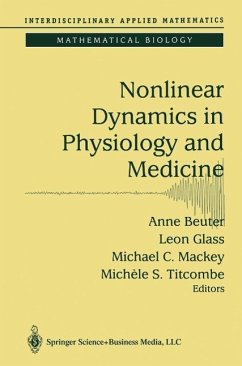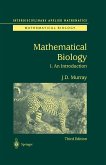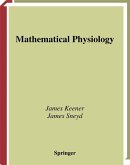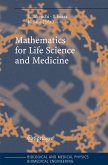This book deals with the application of mathematics in modeling and understanding physiological systems, especially those involving rhythms. It is divided roughly into two sections. In the first part of the book, the authors introduce ideas and techniques from nonlinear dynamics that are relevant to the analysis of biological rhythms. The second part consists of five in-depth case studies in which the authors use the theoretical tools developed earlier to investigate a number of physiological processes: the dynamics of excitable nerve and cardiac tissue, resetting and entrainment of biological oscillators, the effects of noise and time delay on the pupil light reflex, pathologies associated with blood cell replication, and Parkinsonian tremor. One novel feature of the book is the inclusion of classroom-tested computer exercises throughout, designed to form a bridge between the mathematical theory and physiological experiments.
This book will be of interest to studentsand researchers in the natural and physical sciences wanting to learn about the complexities and subtleties of physiological systems from a mathematical perspective.
The authors are members of the Centre for Nonlinear Dynamics in Physiology and Medicine. The material in this book was developed for use in courses and was presented in three Summer Schools run by the authors in Montreal.
This book will be of interest to studentsand researchers in the natural and physical sciences wanting to learn about the complexities and subtleties of physiological systems from a mathematical perspective.
The authors are members of the Centre for Nonlinear Dynamics in Physiology and Medicine. The material in this book was developed for use in courses and was presented in three Summer Schools run by the authors in Montreal.
Dieser Download kann aus rechtlichen Gründen nur mit Rechnungsadresse in A, B, BG, CY, CZ, D, DK, EW, E, FIN, F, GR, HR, H, IRL, I, LT, L, LR, M, NL, PL, P, R, S, SLO, SK ausgeliefert werden.
From the reviews:
"As part of the Springer Interdisciplinary Applied Mathematics Series, this book joins a line of books that are leading the way in showing how mathematics can be usefully applied to biology and physiology." - Bulletin of the AMS, 2004
"This book is an excellent addition to the literature. Perhaps its greatest value is its appeal to a wide class of prospective readers who may range from the biologist (mathematician) who has a mild interest in mathematics (biology) to the researcher who works in one of the fields discussed. ... There is a large bibliography, and there are analytical and computer exercises at the end of each chapter." (Jane Cronin, Zentralblatt MATH, Vol. 1050, 2005)
"The book «Nonlinear Dynamics in Physiology and Medicine» is a multi-author effort. ... Each chapter is well grounded ... . The book's references list is thorough and valid ... . This book is aimed at all scientists studying physiological systems in general ... . It fits into curricula usually offered by bio-engineering departments and - happily more and more - also medical schools. ... a book of high standards and is to be recommended. It is a title worth possessing as a collection of valuable reference material ... ." (Prof. dr. sc. Vladimir Medved, IFMBE News, Vol. 69, November/December, 2004)
"Beuter, Glass, Mackey and Titcombe edit a book that provides an understanding of the theory and application of mathematical tools to the study of physiological systems. The book will be of interest to those involved in the modeling of such physiological systems. ... The material is well written, clear and concise. ... I liked the book. It makes an important contribution to the field ... . I recommend this book. It makes a worthwhile addition to a biological/medical science library." (Paul Johnson, New Zealand Mathematical Society Newsletter, Issue 91, 2004)
"As part of the Springer Interdisciplinary Applied Mathematics Series, this book joins a line of books that are leading the way in showing how mathematics can be usefully applied to biology and physiology." - Bulletin of the AMS, 2004
"This book is an excellent addition to the literature. Perhaps its greatest value is its appeal to a wide class of prospective readers who may range from the biologist (mathematician) who has a mild interest in mathematics (biology) to the researcher who works in one of the fields discussed. ... There is a large bibliography, and there are analytical and computer exercises at the end of each chapter." (Jane Cronin, Zentralblatt MATH, Vol. 1050, 2005)
"The book «Nonlinear Dynamics in Physiology and Medicine» is a multi-author effort. ... Each chapter is well grounded ... . The book's references list is thorough and valid ... . This book is aimed at all scientists studying physiological systems in general ... . It fits into curricula usually offered by bio-engineering departments and - happily more and more - also medical schools. ... a book of high standards and is to be recommended. It is a title worth possessing as a collection of valuable reference material ... ." (Prof. dr. sc. Vladimir Medved, IFMBE News, Vol. 69, November/December, 2004)
"Beuter, Glass, Mackey and Titcombe edit a book that provides an understanding of the theory and application of mathematical tools to the study of physiological systems. The book will be of interest to those involved in the modeling of such physiological systems. ... The material is well written, clear and concise. ... I liked the book. It makes an important contribution to the field ... . I recommend this book. It makes a worthwhile addition to a biological/medical science library." (Paul Johnson, New Zealand Mathematical Society Newsletter, Issue 91, 2004)









